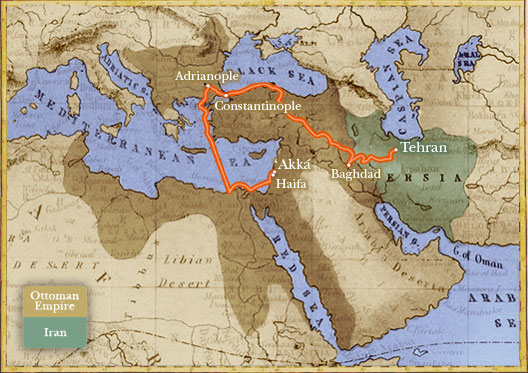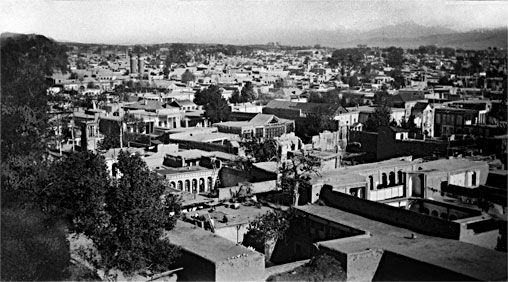The life of Bahá’u’lláh and the events associated with the birth of a new revelation from God unfolded in the 19th century in the Islamic world of Iran and the Ottoman Empire.
The stern control of those two central powers dictated Bahá’u’lláh’s movements His entire life, starting in what was then called Persia, where He was born.
- Previous
- Next

Map with overlay depicting the approximate boundaries of Iran and the Ottoman Empire in 1850 and the route of Bahá’u’lláh’s forced exile from His home in Tehran to the prison city of ‘Akká. Map with modern names and
Bahá’u’lláh, a title that means "the Glory of God" in Arabic, was born on 12 November 1817 in Tehran, Iran. His given name was Husayn Ali, and He was the son of a wealthy government minister, Mirza Buzurg-i-Nuri. The family could trace its ancestry back to the great dynasties of Iran's imperial past. Bahá’u’lláh led a princely life as a young man, receiving an education that focused largely on calligraphy, horsemanship, classic poetry, and swordsmanship.
His son, ‘Abdu’l-Bahá, said this concerning His childhood: "… Bahá’u’lláh, belonged to the nobility of Persia. From earliest childhood He was distinguished among His relatives and friends.… In wisdom, intelligence and as a source of new knowledge, He was advanced beyond His age and superior to His surroundings. All who knew Him were astonished at His precocity. It was usual for them to say, 'Such a child will not live,' for it is commonly believed that precocious children do not reach maturity." (1)
Photo 1 of 12: The city of Tehran, Iran, where Bahá’u’lláh was born
Bahá’u’lláh, a title that means "the Glory of God" in Arabic, was born on 12 November 1817 in Tehran, Iran. His given name was Husayn Ali, and He was the son of a wealthy government minister, Mirza Buzurg-i-Nuri. The family could trace its ancestry back to the great dynasties of Iran's imperial past. Bahá’u’lláh led a princely life as a young man, receiving an education that focused largely on calligraphy, horsemanship, classic poetry, and swordsmanship.
His son, ‘Abdu’l-Bahá, said this concerning His childhood: "… Bahá’u’lláh, belonged to the nobility of Persia. From earliest childhood He was distinguished among His relatives and friends.… In wisdom, intelligence and as a source of new knowledge, He was advanced beyond His age and superior to His surroundings. All who knew Him were astonished at His precocity. It was usual for them to say, 'Such a child will not live,' for it is commonly believed that precocious children do not reach maturity." (1)




 Photograph from the 1930's,of the court -yard of the al-Jazzar Mosque in Acre,Palestine[Since 1948 in Israel].The mosque,built in the classical Ottoman style in 1781 by the Boshnaq, [ Bosnian Ottoman] ruler of the city,Ahmad Pasha al-Jazzar[1775-1804],known for his cruelty[Jazzar=Butcher],who gained fame during Napoleon's failed Syrian campaign in 1799,and was able with the help of the British Navy to foil the French siege of his city.Mr.Farrah,a syrian jewish citizen of Damascus,served as his Secretary,or Prime Minister,and lost his eye as a punishment by his master.The mosque is a land-mark of the Medieval city of Acre,also known as Akka,Acca,Akko,and St.-Jean D'Acre,the Crusaders name of the city and their strong hold in the Holy-Land.,over looking the waters of the Mediterranean sea.
Photograph from the 1930's,of the court -yard of the al-Jazzar Mosque in Acre,Palestine[Since 1948 in Israel].The mosque,built in the classical Ottoman style in 1781 by the Boshnaq, [ Bosnian Ottoman] ruler of the city,Ahmad Pasha al-Jazzar[1775-1804],known for his cruelty[Jazzar=Butcher],who gained fame during Napoleon's failed Syrian campaign in 1799,and was able with the help of the British Navy to foil the French siege of his city.Mr.Farrah,a syrian jewish citizen of Damascus,served as his Secretary,or Prime Minister,and lost his eye as a punishment by his master.The mosque is a land-mark of the Medieval city of Acre,also known as Akka,Acca,Akko,and St.-Jean D'Acre,the Crusaders name of the city and their strong hold in the Holy-Land.,over looking the waters of the Mediterranean sea.
 A commercial Stereoscope of Iraqis sitting in a Mosul Cafe.
A commercial Stereoscope of Iraqis sitting in a Mosul Cafe.


.jpg)